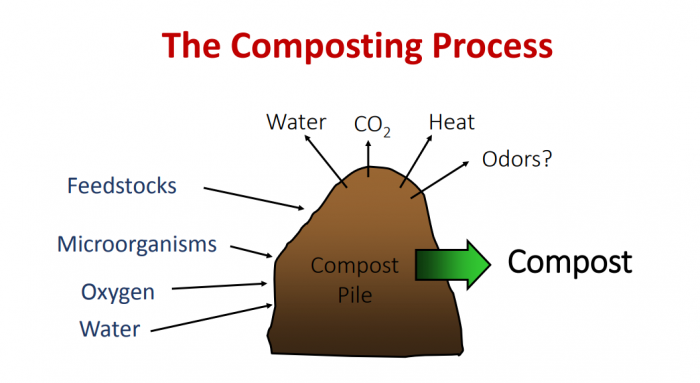The Composting Process
• Microbes consume feedstocks to obtain energy & nutrients
• Their activity creates heat
•Heat gets trapped in a pile
• Accelerates process
TYPES OF COMPOST, WHAT TO COMPOST
What Microbes Need
• Carbon (sugars) fuels their metabolism
• Nitrogen (protein) makes enzymes used in
decay process
• Moisture transports and supports life functions
• Oxygen
• Hospitable environment
How Microbes ‘Eat’
• Secrete enzymes to dissolve organics
• Enzymes are specialized proteins that break chemical bonds
• Only relatively small organic compounds can cross cell
membrane
Microorganisms Involved in the Composting Process
•Bacteria
•Fungi
•Actinomycetes
•Protozoa
•Rotifers
Bacteria
• Smallest living organisms
• 250,000 – 500,000 fit inside a period!
• 1 teaspoon soil has 100 million – 1 billion
• Consume simple carbon compounds
• 80-90% of microbes in a compost pile
• Responsible for most of the decomposition and heat generation in compost
Fungi
• Molds, yeasts, mushrooms
• Numerous during mesophilic phases
• When temperatures are high, most fungi live in the outer layer of compost
• Break down tough organic debris
• Cellulose, hemicellulose, lignin
• Can decompose materials too dry, acidic, or low in nitrogen for bacterial activity
Actinomycetes
• Cause earthy smell
• Bacteria with filaments (resemble fungi)
• Look like gray spider webs
• Degrade cellulose, lignin, chitin, proteins
• Bark, woody stems, paper
• Live in a wider range of pH than other bacteria
• Some species in the thermophilic phase, others in the curing phase
Protozoa
• One-celled microscopic animals
• Live in water droplets in compost
• Play a minor role in decomposition
• Feed on organic matter, bacteria, and fungi
Rotifers
• Microscopic multicellular organisms
• Also found in water drops in compost
• Also eat organic matter, bacteria, and fungi
Stage 1 Activity Bacteria break down cellulose into glucose (sugars, protein, starch)
• Makes temperatures in pile rise
• Produce endospores as pile heats up Endospores
• Bacteria develop the tough coating
• Resists heat, drying, UV radiation, chemicals
• Can survive next, hotter phase then return to the active state when cool again
Stage 2 Activity
• Thermophilic bacteria, fungi take over
• Heat-intolerant microbes go dormant
• Pathogens (human, plant) destroyed
• Complex carbohydrates fully are broken down
• Some proteins are decomposed
• Hemicelluloses (more resistant) decay
All this activity makes the temperature continue to rise!
Stage 3 Activity
• Mesophilic microbes return to an active state
• Proteins and carbs diminish
• Metabolic activity decreases
• Temperatures in pile drop
• Lignin (most resistant plant component) decayed by actinomycetes, fungi
Stage 3 continued
• Physical decomposers support microbes
• The matter gets exposed to bacteria as arthropods forage
• Allows microbial populations to increase Earthworms, mites, spiders, ants, snails, sowbugs, slugs, nematodes, springtails, centipedes, etc.
Summary: Succession of Microbial Communities During Composting
• Mesophilic bacteria break down soluble, readily degradable compounds (sugars and starches)
• Thermophilic bacteria break down proteins, fats; work with actinomycetes to begin breaking down cellulose and hemicellulose
• Actinomycetes and fungi are important during curing phase in attacking most resistant compounds






Read 0 comments and reply